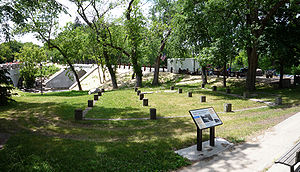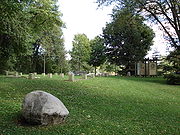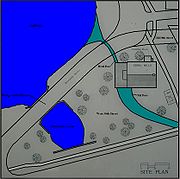
Edina Mill
Encyclopedia

Gristmill
The terms gristmill or grist mill can refer either to a building in which grain is ground into flour, or to the grinding mechanism itself.- Early history :...
s to be built on the Minnehaha Creek in Hennepin County, Minnesota
Hennepin County, Minnesota
Hennepin County is a county located in the U.S. state of Minnesota, named in honor of the 17th-century explorer Father Louis Hennepin. As of 2010 the population was 1,152,425. Its county seat is Minneapolis. It is by far the most populous county in Minnesota; more than one in five Minnesotans live...
between 1855 and 1876. Located in present day Edina
Edina, Minnesota
Edina is a city in Hennepin County, Minnesota, United States, and a first-ring suburb situated immediately southwest of Minneapolis. Edina began as a small farming and milling community in the 1860s. The population was 47,941 at the 2010 census.-Geography:...
, the mill site was discovered during an expedition from Fort Snelling to Lake Minnetonka
Lake Minnetonka
Lake Minnetonka is a lake in the U.S. state of Minnesota. Throughout its recorded history, the lake has been a resort destination. It is located west-southwest of Minneapolis-St. Paul. The lake is an irregular shape with numerous bays and islands which make up about of shoreline...
in 1822. Although the original mill structure was demolished in 1932, its former site is preserved with foundation markers and informational exhibits.
History
In the mid-1850s, small gristmills began to spring up along several creeks that ran through the land where much of the area's grain was grown. This was a direct result of the fact that prior to these mills, farmers had to haul their grain in horse-drawn wagons over long distances to the mills at Saint Anthony FallsSaint Anthony Falls
Saint Anthony Falls, or the Falls of Saint Anthony, located northeast of downtown Minneapolis, Minnesota, was the only natural major waterfall on the Upper Mississippi River. The natural falls was replaced by a concrete overflow spillway after it partially collapsed in 1869...
along the Mississippi River
Mississippi River
The Mississippi River is the largest river system in North America. Flowing entirely in the United States, this river rises in western Minnesota and meanders slowly southwards for to the Mississippi River Delta at the Gulf of Mexico. With its many tributaries, the Mississippi's watershed drains...
.
Waterville Mills
In 1856, Jacob Elliot, Captain Richard Strout, Levi M. Stewart, and Joseph Cushman purchased land and constructed a mill on the Minnehaha Creek in present day Edina. The mill and the tiny settlement that sprang up around it were named Waterville Mills. Pioneer farmers brought their wheatWheat
Wheat is a cereal grain, originally from the Levant region of the Near East, but now cultivated worldwide. In 2007 world production of wheat was 607 million tons, making it the third most-produced cereal after maize and rice...
, rye
Rye
Rye is a grass grown extensively as a grain and as a forage crop. It is a member of the wheat tribe and is closely related to barley and wheat. Rye grain is used for flour, rye bread, rye beer, some whiskeys, some vodkas, and animal fodder...
, oats
OATS
OATS - Open Source Assistive Technology Software - is a source code repository or "forge" for assistive technology software. It was launched in 2006 with the goal to provide a one-stop “shop” for end users, clinicians and open-source developers to promote and develop open source assistive...
, barley
Barley
Barley is a major cereal grain, a member of the grass family. It serves as a major animal fodder, as a base malt for beer and certain distilled beverages, and as a component of various health foods...
and corn
Maize
Maize known in many English-speaking countries as corn or mielie/mealie, is a grain domesticated by indigenous peoples in Mesoamerica in prehistoric times. The leafy stalk produces ears which contain seeds called kernels. Though technically a grain, maize kernels are used in cooking as a vegetable...
from as far away as Excelsior
Excelsior, Minnesota
Excelsior is a settlement on Lake Minnetonka in Hennepin County, Minnesota, United States. The population was 2,188 at the 2010 census.-Geography:...
and St. Anthony. In 1859, the mill was resold to William Rheem and Jonathan T. Grimes
Jonathan Taylor Grimes House
The Jonathan Taylor Grimes House is the oldest standing house in Edina, Minnesota. It was built in 1869 and appears to have been influenced by Andrew Jackson Downing's book The Architecture of Country Houses. The house is a 1½ story frame cottage with intersecting gable roofs, dormers, a bay...
who renamed it the Red Mill. They kept the mill running constantly during the Civil War
American Civil War
The American Civil War was a civil war fought in the United States of America. In response to the election of Abraham Lincoln as President of the United States, 11 southern slave states declared their secession from the United States and formed the Confederate States of America ; the other 25...
making flour requisitioned by the government for the Union Army
Union Army
The Union Army was the land force that fought for the Union during the American Civil War. It was also known as the Federal Army, the U.S. Army, the Northern Army and the National Army...
. In 1867, the mill was again resold to Daniel H. Buckwalter who again changed the name of the mill to the Buckwalter Mill.

New Name
After only two years Buckwalter sold the mill to a Scotsman named Andrew Craik in 1869. He gave the mill and the city of Edina its present name. Edina was a nickname for his birthplace in EdinburghEdinburgh
Edinburgh is the capital city of Scotland, the second largest city in Scotland, and the eighth most populous in the United Kingdom. The City of Edinburgh Council governs one of Scotland's 32 local government council areas. The council area includes urban Edinburgh and a rural area...
, Scotland
Scotland
Scotland is a country that is part of the United Kingdom. Occupying the northern third of the island of Great Britain, it shares a border with England to the south and is bounded by the North Sea to the east, the Atlantic Ocean to the north and west, and the North Channel and Irish Sea to the...
, that appeared in a poem written by Scottish poet Robert Burns
Robert Burns
Robert Burns was a Scottish poet and a lyricist. He is widely regarded as the national poet of Scotland, and is celebrated worldwide...
. Along with the new name, Craik also brought two new products, oatmeal
Oatmeal
Oatmeal is ground oat groats , or a porridge made from oats . Oatmeal can also be ground oat, steel-cut oats, crushed oats, or rolled oats....
and pearl barley
Pearl barley
Pearl barley is barley processed to remove its hull and bran. Barley must have its fibrous outer hull removed before it can be eaten; pearl barley is taken a step further, polished to remove the nutritious bran layer....
. The Edina Mill was the first in the state of Minnesota to make them and for many years it was the only place in the area to get them. In 1875, George Millam, a Scottish miller hired by Craik shortly after he bought it, purchased the mill from Craik and converted from a wooden overshot water wheel
Water wheel
A water wheel is a machine for converting the energy of free-flowing or falling water into useful forms of power. A water wheel consists of a large wooden or metal wheel, with a number of blades or buckets arranged on the outside rim forming the driving surface...
to turbine
Turbine
A turbine is a rotary engine that extracts energy from a fluid flow and converts it into useful work.The simplest turbines have one moving part, a rotor assembly, which is a shaft or drum with blades attached. Moving fluid acts on the blades, or the blades react to the flow, so that they move and...
power. By 1879, three turbines drove the millstones and other milling machinery.
Demise
The demise of the mill began in 1895 when a damDam
A dam is a barrier that impounds water or underground streams. Dams generally serve the primary purpose of retaining water, while other structures such as floodgates or levees are used to manage or prevent water flow into specific land regions. Hydropower and pumped-storage hydroelectricity are...
was built on the east shore of Gray's Bay on Lake Minnetonka. This dam severely cut the water flow of the Minnehaha Creek, turning it from a racing river to a meandering brook. A last attempt was made to keep the mill running and for a time, a gas engine was used to grind feed for livestock
Livestock
Livestock refers to one or more domesticated animals raised in an agricultural setting to produce commodities such as food, fiber and labor. The term "livestock" as used in this article does not include poultry or farmed fish; however the inclusion of these, especially poultry, within the meaning...
. However, it didn't work out and the mill came to a halt never to start again.

Country Club District (Minneapolis)
The Country Club District is a 20th century neighborhood in Edina, Minnesota, a suburb of Minneapolis, of primarily Colonial Revival, Tudorbethan style, also called Mock Tudor, Georgian Revival and Mediterranean Revival designs.-External links:*...
. On December 1, 1932, despite efforts to preserve it as an historic landmark, the old mill was demolished.

